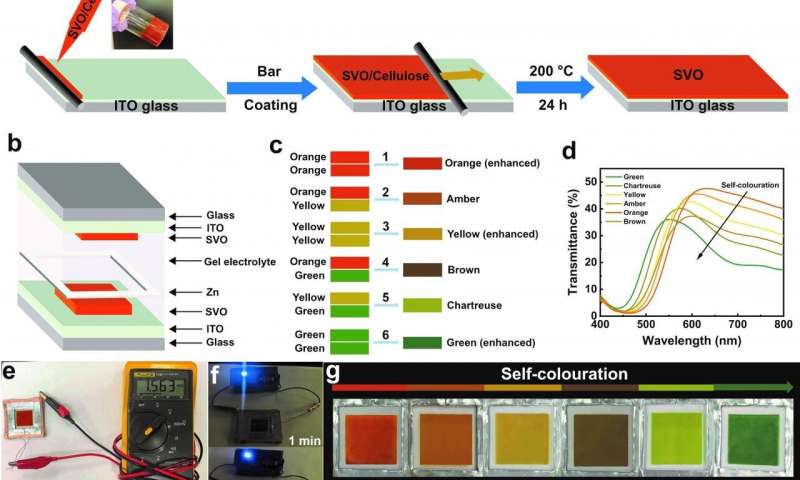HOME
Transparent inorganic multicolour displays enabled by zinc-based electrochromic devices

a, Schematic diagram of the bar-coating process. The inset shows a digital photograph of the SVO/cellulose paste. b, Schematic illustration of a Zn-SVO electrochromic display platform. c, Schematic illustration of the colour overlay effect via the combination of orange, yellow, and green colours. The upper colour code represents the colour of the top SVO electrode, while the lower colour code represents the colour of the bottom SVO electrode. d, Visible-near infrared transmittance spectra of the display under different colour states. e, Digital photograph of the display having an orange colour, showing an OCP of 1.56 V. f, Digital photographs of a 0.5 V regulated LED powered by the Zn-SVO electrochromic display at 1 min and 40 mins. g, Digital photographs of the Zn-SVO display showing six colours obtained through the colour overlay effect. Credit: by Wu Zhang, Haizeng Li, William W. Yu, Abdulhakem Y. Elezzabi
Multicolour electrochromic displays are one of the most versatile applications because they can retain their colored states without the need to supply electrical power. However, the simultaneous colouration of the counter layer when operating a conventional electrochromic display restricts the color overlay effects. Additionally, the operation of conventional electrochromic displays requires external voltages to trigger the colouration/bleaching processes, which makes the conventional electrochromic displays far from a net-zero energy consumption technology.
In a new paper published in Light Science & Applications, a team of scientists, led by Professor Abdulhakem Y. Elezzabi and Dr. Haizeng Li from Ultrafast Optics and Nanophotonics Laboratory, Department of Electrical and Computer Engineering, University of Alberta, Canada, and co-workers have developed a novel concept for transparent multicolour electrochromic displays by employing sodium ion stabilized vanadium oxide (SVO) nanorods as the electrochromic material. The SVO nanorods are compatible with a simple bar-coating method for fabricating electrochromic films when mixed with cellulose. Due to the oxidation nature of SVO, the added cellulose can be fully decomposed under a low temperature (200 °C) to prevent its influence on the conductivity.
The SVO film exhibits reversible multicolour switching (orange ⇄ yellow ⇄ green) during the Zn2+ insertion (self-coloring/discharging) and extraction (bleaching/charging). By taking advantage of the three-color (orange ⇄ yellow ⇄ green) electrochromic response of the SVO film, an electrochromic display was constructed by sandwiching zinc foil between two SVO electrodes. This display enables independent operation of top and bottom electrochromic electrodes, thus providing additional configuration flexibility of the devices through the utilization of dual electrochromic layers under the same or different color states. As such, the color overlay effect can greatly broaden the color palette. Using the color overlay effect, the constructed Zn-SVO electrochromic display shows switching between the multiple colors (orange, amber, yellow, brown, chartreuse and green) while maintaining semitransparency of >30%.
News Source